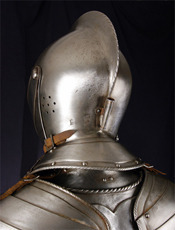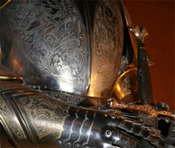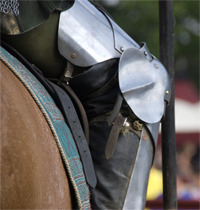How To Undress Your Knight in Shining Armor
 Suppose you're a 21st century gal who is suddenly transported to medieval times (yes, I'm sure this happens all the time). You meet your knight in shining armor and now it is time to…well, get to know each other better. Unfortunately, he is encased in the world's largest chastity belt and you've neglected to pack your bolt cutters. So how do you pry your knight out of his metal suit?
Suppose you're a 21st century gal who is suddenly transported to medieval times (yes, I'm sure this happens all the time). You meet your knight in shining armor and now it is time to…well, get to know each other better. Unfortunately, he is encased in the world's largest chastity belt and you've neglected to pack your bolt cutters. So how do you pry your knight out of his metal suit?
Fear not, his squire got him into his harness (suit of armor) and you're going to get him out. If your knight is armed in full plate "cap-a-pie" (an old French saying meaning "head to foot") then you have time warped into the mid-fifteenth century. Despite looking like an impossible burden, most suits of armor were surprisingly flexible and weighed 45-55 pounds, about what today's infantryman carries. Unfortunately, this armor was exceedingly hot and many a knight survived the battle only to die later of heat stroke or suffocation. So let us begin to extricate your man post haste.
 The first step is to start with the helmet. Look around the back to find leather straps and buckles that attach the wrapper, a metal piece in front of the helmet, to the armet (the rest of the helmet). Underneath, your knight may be wearing a rather goofy looking quilted bonnet tied under his chin. Never fear, this is easily removed and serves to prevent brain damage from occurring during combat (a knight who can recall his own name is always preferable to one who can not). Now you can step back and take a good look. If his visage is appealing, give him a saucy wink and continue on.
The first step is to start with the helmet. Look around the back to find leather straps and buckles that attach the wrapper, a metal piece in front of the helmet, to the armet (the rest of the helmet). Underneath, your knight may be wearing a rather goofy looking quilted bonnet tied under his chin. Never fear, this is easily removed and serves to prevent brain damage from occurring during combat (a knight who can recall his own name is always preferable to one who can not). Now you can step back and take a good look. If his visage is appealing, give him a saucy wink and continue on.
The gauntlets should be easy to remove by slipping them off, possibly with a strap at the inner forearm. Next is the armor on the arms, called the vambrace, which is actually in three pieces covering the shoulders, elbows, and forearms. The shoulders were particularly vulnerable to attack from sideways hits and downward blows that glanced off the helmet. Thus, the pauldron, or shoulder armor, was often substantial, giving your knight that husky linebacker look. To remove, the shoulder plates were tied to the top of the shoulder using waxed leather laces, which attached the pauldron to the arming doublet worn underneath. The pauldron was also strapped under the arm. The rest of the vambrace, an elbow piece called a couter and the lower cannon that encased the forearm, was attached the same way, tied to the arming doublet and strapped around the arm.
 Once the arm defenses are removed, you come to the cuirass, which covers the chest and back. The steel plate armor could be formed so it followed the fashion of the day and was often ornately decorated. Since your knight has spent a considerable sum on his armor, take a moment to admire the craftsmanship and show him you appreciate the cost.
Once the arm defenses are removed, you come to the cuirass, which covers the chest and back. The steel plate armor could be formed so it followed the fashion of the day and was often ornately decorated. Since your knight has spent a considerable sum on his armor, take a moment to admire the craftsmanship and show him you appreciate the cost.
The cuirass in the 15th century was made of several pieces to allow movement and was hinged together on the left side so it can be removed in one piece. The left side of a knight was more likely to be hit, so the straps holding it together will be found on the right. Undo the buckles and the entire unit should slide off. A thick iron chain mail collar called a standard, used to protect the neck, can be removed over the head.
The leg defenses are easy to remove as they are simply strapped in the back of the leg. The cuisse protects the thigh and may also be laced at the top to the arming doublet. Moving down the legs, the poleyn covers the knee, the greave covers the shin, and the sabaton covers the foot. Once these are removed your knight should be looking a bit more human and a lot less cy-borg.
 Under all this armor, your knight will be wearing an arming doublet and long woolen hose, much like stockings, that have built in leather soles at the bottom of the feet for shoes. The arming doublet has special leather laces fitted with metal tips or "points" with which to attach the pieces of the armor. The doublet also has gussets or sections of chain mail along the inside of the arms to protect places that are not covered by plate when fully armed. A chain mail skirt will be tied or "pointed" to the arming doublet. This skirt serves to protect the knight's private parts…let us hope it has done its job well.
Under all this armor, your knight will be wearing an arming doublet and long woolen hose, much like stockings, that have built in leather soles at the bottom of the feet for shoes. The arming doublet has special leather laces fitted with metal tips or "points" with which to attach the pieces of the armor. The doublet also has gussets or sections of chain mail along the inside of the arms to protect places that are not covered by plate when fully armed. A chain mail skirt will be tied or "pointed" to the arming doublet. This skirt serves to protect the knight's private parts…let us hope it has done its job well.
The woolen hose is tied at the top to the arming doublet. These can be untied and removed revealing linen drawers, like the modern day boxer shorts. The doublet can be untied in front uncovering a loose fitting linen shirt. Once you have removed the shirt you will have your knight in discarded armor wearing nothing more than shorts and a smile. I think you can take it from here!

Please note: Man in picture is representational only. Actual results may vary.
References:
Gravett, C. (1996). The World of the Medieval Knight. Peter Bedrick Books, New York.
Wise, T. (1976). Medieval Warfare. Osprey Publishing Ltd., London.
Also check out a Pictorial Glossary of Armor to see pictures of many of the armor pieces described above.
Amanda Forester's Blog
- Amanda Forester's profile
- 325 followers



